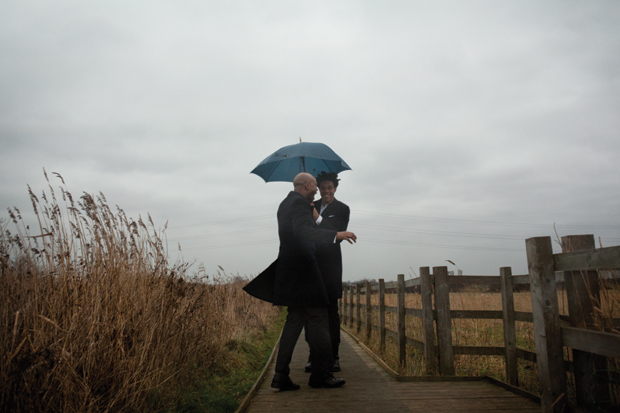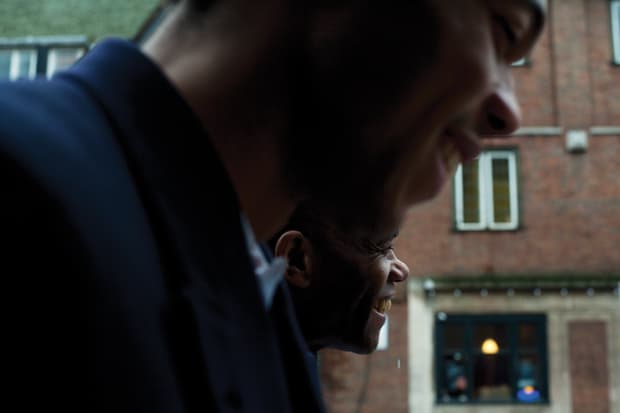Joe Casely-Hayford and his son Charlie share a small two-floor studio in the Shoreditch section of London. The top floor is clean as a whistle, a showroom for their menswear brand, where each season’s clothes are displayed for buyers and press. Below is their workspace, strewn with thousands of sketches on stacked white paper. The short staircase that divides the two is more like a conveyor belt for Joe and Charlie, who run back and forth, trading places constantly. Charlie’s mother and Joe’s wife Maria is in and out, too, running the business while the two boys focus on balancing their creative urges. The whole family lives just blocks away, Charlie in an apartment of his own but close to the house he grew up in, where his parents still reside.
Both Joe and Charlie were born on the same day, May 24, two decades apart. They’re Geminis, the Zodiac sign represented by the two twins of Greek myth, Castor and Pollux. Geminis are said to have two people in one body and a personality split a mile wide. But Joe and Charlie seem to have found a happy medium for their multiple sides, creating the eponymous father-son fashion line Casely-Hayford that reads like cotton hieroglyphics of the unspoken language between them. Colors for their newest collection come from a hereditary love of Georgia O’Keeffe’s desert palate, for instance, and long linen shirts are directly inspired by a silhouette common with the Bangladeshi men that live in their neighborhood, a look Charlie loved as a kid. Examine any sleeve they’ve ever sewn and you’ll get a little swatch of family history.

Casely-Hayford is Charlie’s first commercial venture since leaving art school at Central St. Martins. At 24, he is decidedly more comfortable representing the brand than his father—relaxed, talkative and excited. Charlie calls Joe by his name instead of “dad,” a signifier of their insistence that every collection start with a open exchange of ideas. There are moments when Joe plays the trump card, vetoing Charlie from a point of experience, but for the most part, they both seem intent on learning from each other. Charlie’s inexperience and instinct can be just as effective a design tool as Joe’s technical expertise. And sometimes, in a generational switch, it’s Charlie that remembers the good ol’ days. Each season, he picks one piece from his father’s design archive to re-imagine for Casely-Hayford, a method that Joe seems hesitant to embrace, weary of repeating himself. But the fact that tradition can be strangely revolutionary for his generation can’t be lost on Charlie, a kid who’s first job out of college is working with his pops.
Joe’s youthful rebellion was more abrupt, a classic tale of breaking with mom and dad and a prestigious family filled with politicians and lawyers. He wore ladies’ Manolo Blahniks his first years at school, intent on conveying insurgency through clothing, a revelation that surprises even his son. Joe is almost aristocratically polite now, hardly a gender bender in his midnight blue suit and sensible shoes. But he started designing at a young age, in love with London punk’s mix of safety pins and Savile Row, where he also trained. His first collection bridged the gap between England’s great history of tailoring and things weirder. Joe bought a huge consignment of World War II army tents from a friend. They had been through a war, were distressed and filthy, but he cut up the canvas and made proper jackets, trousers and shirts and sold them. And since then, that simultaneous reverence and rejection of refined taste has remained one of the only constants. Men in Casely-Hayford clothes look like they can’t decide if they’re rich or poor, responsible or careless, gainfully employed or anarchists. It’s haphazard but never random, two men channeling exponential identities through cloth. Over a cup of Earl Grey, they try their best to explain exactly who they are.

Joe Casely-Hayford:
My grandfather, he wrote a book called Ethiopia Unbound, which was probably one of the first books to be published by a black African in English. It was about the idea of duality and double-consciousness, what W.E.B Du Bois talked about, that when you’re black you’re never just one identity; you’re aware of both yourself and how you’re viewed by the majority at all times. My grandfather wore Kente cloth to study at Cambridge, and Savile Row to visit family in Ghana. He didn’t make clothes, but what he wore was political. He was very much interested in the idea of African emancipation and black people thinking in much broader terms than they had been allowed to.
I was always classified as a “black designer,” so I had to struggle to work against that. I was into punk. I made clothes for The Clash. There weren’t African elements in my clothes until later in my career, even though people always expected them. I wanted to be seen as “the designer.” I just felt the idea of hip-hop culture being the focal point of black identity was something quite narrow, and that there should be other diverse elements. As a young kid I liked rock and heavy metal.
I’ve noticed that’s different in the way Charlie and I are because of my age and the things I’ve experienced, in terms of being a black man. He likes everything, too, but I think that means something different in the 21st century. Maybe political clothes aren’t as relevant anymore. It’s a different context now, but at the time I felt that you could make a political statement with clothing. People like Vivienne Westwood were making such challenging clothes. Loads of people think fashion is quite trivial, but in that respect I think I convey quite serious ideas through designing clothing.
In terms of social progress, I feel a lot more comfortable in this time now, where we are perceived as just designers. And it’s funny, one of the reasons why we explore the Afro-punk so heavily in Casely-Hayford is because Charlie still responded deeply to clothes I had designed in the past that were political. I have to be careful. If I always do things I’ve already done then I’d get bored very quickly. But in the 21st century, it’s less about the politics and more just about history and concept, so it’s different. Our newest collection could be British, it could be African, it could be Bedouin. And that’s the point.

Charlie Casely-Hayford:
It’s hard to find pictures of Dad’s older stuff because anything pre-internet almost doesn’t exist. It’s crazy. But it’s okay for me because he has an entire archive that I just sift through. When I was a baby he’d actually make miniature versions of his collections for me, so I’d wear suits and boots from his first collections as a toddler. When I was 11 or 12, my dad’s clothes were very avant-garde. He’d give me clothes from his collection, but I’d stash them in my wardrobe and wear them only two years later. It was so ahead of its time that I just didn’t get it. As a kid, it’s hard when your father’s a lot cooler than you. He was the one, not my friends, who introduced me to all my favorite music. My mom and him met in college. He doesn’t talk much about his past, but the other day she told me he used to wear the most amazing things every day. I went to the same school as both my parents, but I studied very traditional classicism. In some ways, I’m more conservative than he is.
We don’t fight, but we do disagree every day. If we were on the same page, it would be pointless. Sometimes he doesn’t know where I’m coming from though. There’s never a cut-off point, we’ll just argue about an item until we come to a conclusion. There’s a white coat in the new collection, a very simple, basic straight coat. When I brought the idea to him he said, “No way, we can’t go there.” He felt that it had been done before, that a designer of his generation could produce something like that without any thought. And I was trying to convince him that it was new. It wasn’t the garment that was new, it was the concept, the idea, the process. We’re coming at the same thing from different perspectives. I spent days, weeks trying to convince him that I was behind the narrative of the jacket, that it was fresh to me. I convinced him. He told me recently that it’s grown on him.
We’ve got a piece in the newest collection, a leather coat that’s bottom you can zip off to make a shorter jacket. That was based on something he designed for womenswear in the 1980s, it was a top with zip-away hot pants. He gets really mad if I bring other people’s look books or designs into the studio, he wants my ideas to be fresh. But we do work off of his heritage. It’s tradition, my dad’s tradition, that Casely-Hayford represents. I want this to be a family business, I want it to have a future. I’m trying to build something
